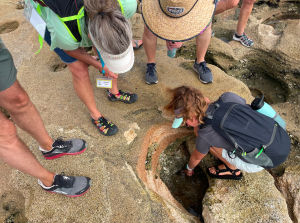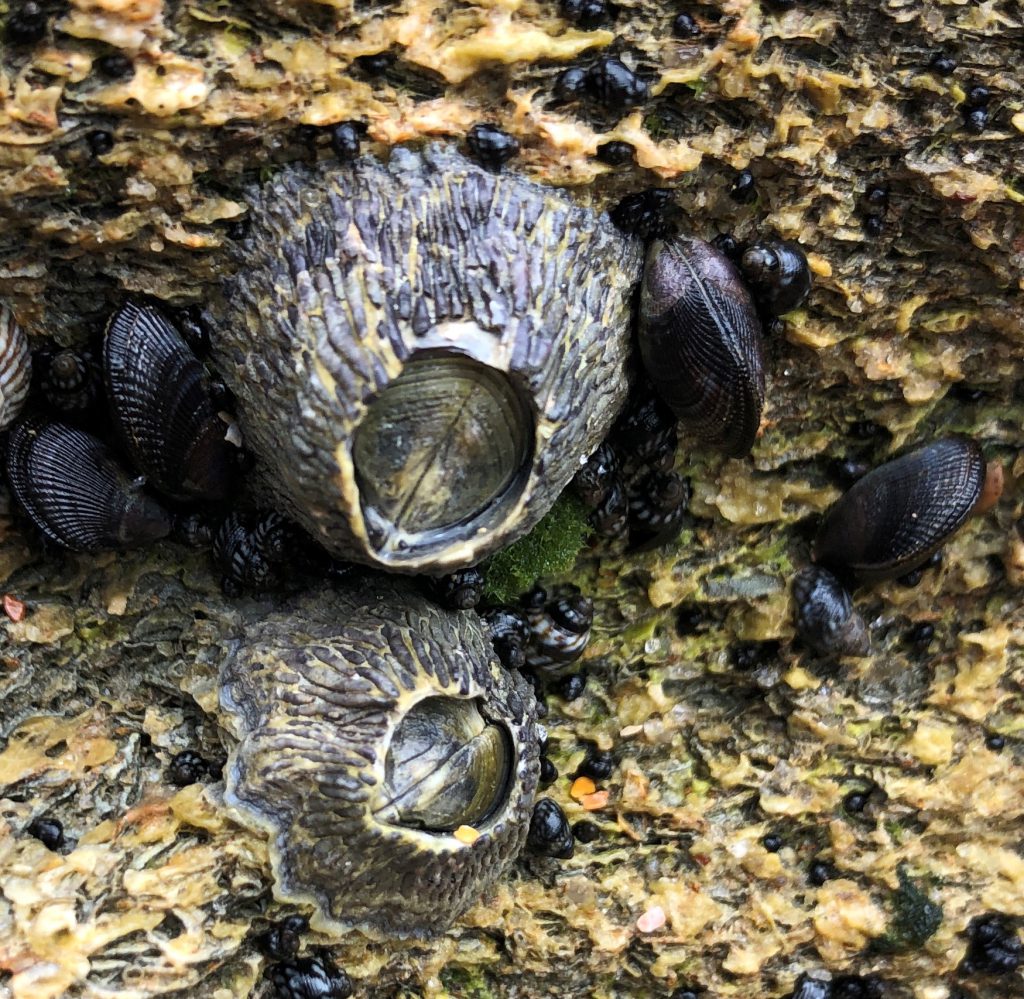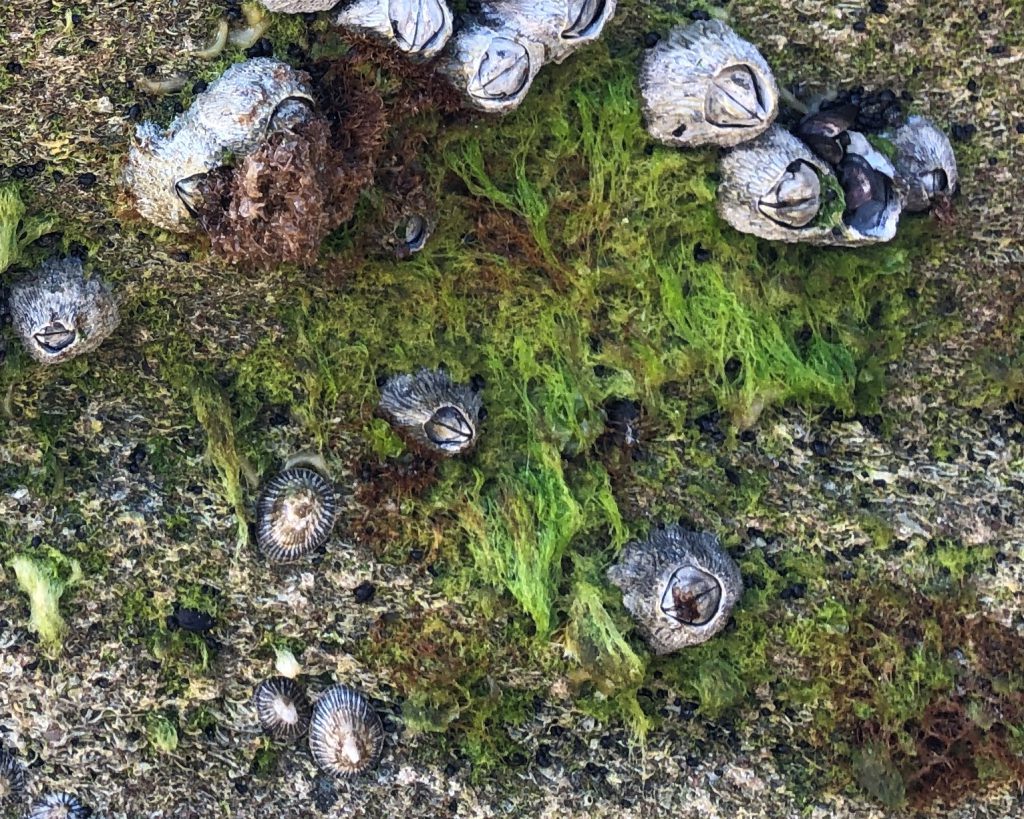June 8 is World Ocean Day, and we want you to get outside and explore our coastal environment!

One of my favorite places to explore the coast in the area is the River to Sea Preserve at Marineland, located in northern Flagler County. This spot is unique to Florida in that there is a rocky intertidal zone. Here, there are a series of coquina rock formations that are exposed and create some amazing structures and habitat to find creatures you don’t often see along the sandy Florida beaches. Take this post as your guide to explore the coast and learn about some of the marine organisms you might find there, whether you get out on June 8th or any other day of the year that you decide is your Ocean Day!
Where are we going?

For this field trip we are headed to River to Sea Preserve, which is run by Flagler County Parks and Recreation. It is located at 9805 N. Oceanshore Blvd, Marineland, FL 32137. The park has two access points with separate parking lots, both of which offer free parking. The larger lot is located on the oceanside of A1A and has a bathroom. If you access the beach from this site, you will need to walk south along the beach a little bit to reach the main rocky area. The smaller lot is located across from A1A just to the south and has a port-a-potty. If you park here, you will need to cross A1A (take caution for vehicles) and there is a path that takes you to the beach just in front of the rocky area. Always be sure to stay on boardwalks or designated paths when crossing sand dunes so that we do not cause any damage or erosion to the dunes.
What do I need to do ahead of time to prepare?
Check the tides! This site can change over time with storms and how much sand is on the beach, but generally it is best to visit will be at mid or low tide (at high tide more of the rocks will be covered in water!). I like to visit as the tide is going out and almost low, as we are most likely to find creatures in the tide pools. You can use the NOAA Tides and Currents page to look up the tide for the day you want to go. On Thursday, June 8th, 2023, high tide will be around 12:30 pm and we will have low tides around 7 am or 7 pm. This means it would work out great to get down to the beach in the early morning or in the late afternoon after work.

Dress appropriately for the conditions. I recommend wearing hard-soled shoes, as the rocks may have oyster shell or other sharp edges that could cut feet. A hat, sunglasses, and a lightweight long sleeve shirt are all a great idea for protecting yourself from the sun and staying cool. Since the UV index in Florida is usually high, you also want to remember your sunscreen!
And of course, please remember your reusable water bottle full of water so that you stay hydrated! Reusable water bottles are great as many are insulated to keep your water cool and we reduce the amount of single-use plastic waste that is in our community.
What are these rocks?
The rocks in this area are a type of coquina, which is a limestone rock formed by small shells and sand. Rainwater that was mildly acidic dissolves some of the calcium carbonate in the shells of coquina clams and other mollusks, and it “glued” the shells and sand together. We don’t know exactly when these rocks were formed, but it was probably around 100,000 years ago. These rocks of the Anastasia formation, which runs from St. Augustine down to Palm Beach County, but most of it is buried beneath layers of sand. We are lucky to have this area exposed! (You can also find coquina rock exposed just down the road at Washington Oaks State Park, but at the time of writing the beach entrance of the park has not reopened due to hurricane damage).
You will also see some holes that are formed by erosion from the acidic rain that filled small depressions and grew over time. These holes provide a great habitat for creatures to be protected from incoming crashing waves!


What will we see?
Here is the really fun part – looking for organisms! You will mostly find invertebrates here, which are animals that don’t have a backbone. Many of the invertebrates here are types of mollusks, including mussels, snails, and false limpets. There are also lots of barnacles on the rocks, both the larger ribbed barnacles and smaller species. All of these creatures require something solid to attach to, which is why we find them here on the coquina rock formations! They are also all adapted to living in the intertidal zone, where they might be underwater for part of the day and exposed to air for part of the day. You will also want to carefully check the holes and any tidepools for anemones, crabs and small fish!
Below are some photos and information to help you identify some of the organisms you can expect to encounter on your field trip!
Strpiped false limpet

The striped false limpet is a type of mollusk and has a soft body underneath a single, rounded shell with stripes that radiate out from the center. Unlike keyhole limpets, this false limpet is related to land snails and breathes air. They can move but do so very slowly and you probably won’t be able to notice! How many can you count on one rock?
Quiet periwinkle snails

Quiet periwinkle snails are small black and white snails. The ones I have seen at River to Sea Preserve are very small (a half inch or less in size) and usually tuck themselves away into crevices in the rocks for protection from the waves.
Florida rock snail

If you find some larger snails, they may be Florida rock snails (Stramonita haemastoma floridana). These predatory snails feed on mussels and oysters by drilling a hole into the shell of their prey using a specialized tooth called a radula. We found several grouped together, which may be a tactic to feed more efficiently!
Ribbed barnacles

The large barnacles that you see on the rocks are ribbed barnacles. At high tide, when they are covered in water, they will open up and extend feather-like appendages called cirri. They use their cirri to capture microscopic particles of food in the water. At low tide when the barnacles are exposed to the air, they will close themselves up so they don’t dry out, which is how we usually see them. Even though barnacles have a shell that makes them look like some of the other mollusks, they are actually a type of crustacean and are more closely related to crabs!
In this photo you can also see some small mussels, which are a type of mollusk and have a soft body inside their shells. They are bivalves, which means that they have two shells. Similar to the barnacles, they stay closed during low tide but open up at high tide to feed on microorganisms in the water.
Warty anemone

The warty anemone is a common species of anemone in Florida. It is a cnidarian, related to corals and jellyfish. It uses its tentacles to capture small food items and bring them to its mouth, located in the center. When they are covered in water the anemone will have its tentacles extended. However, if the water recedes, the anemone will pull its tentacles in and close itself up almost like a little ball to retain moisture.
Algae

Rocks are also covered in many species of green, red, and brown algae. They will look different depending on whether it is in the water or lightly dried out. Be cautious when walking on rocks with algae as they could be slippery! As you can see from the photo, many types of organisms mix together on the rocks, and you may find algae, barnacles, snails, and false limpets all in the same area!
Guiding questions
As you explore the area, here are some things to think about and discuss with your group:
- Which organism did you find the most interesting? Why?
- Which organisms were most common closest to the ocean? Which were more common further up the beach? Why do you think that is?
- How do the shapes of the coquina rock affect where you find more invertebrates?
- If you are able to visit the preserve multiple times, what differences do you find between high and low tide?
Feel free to share your experiences with us in the comments section as well! Did you find any new organisms during your visit? If you take a photo, share it with us and we will try to help identify it and add it to our guide!
 0
0
